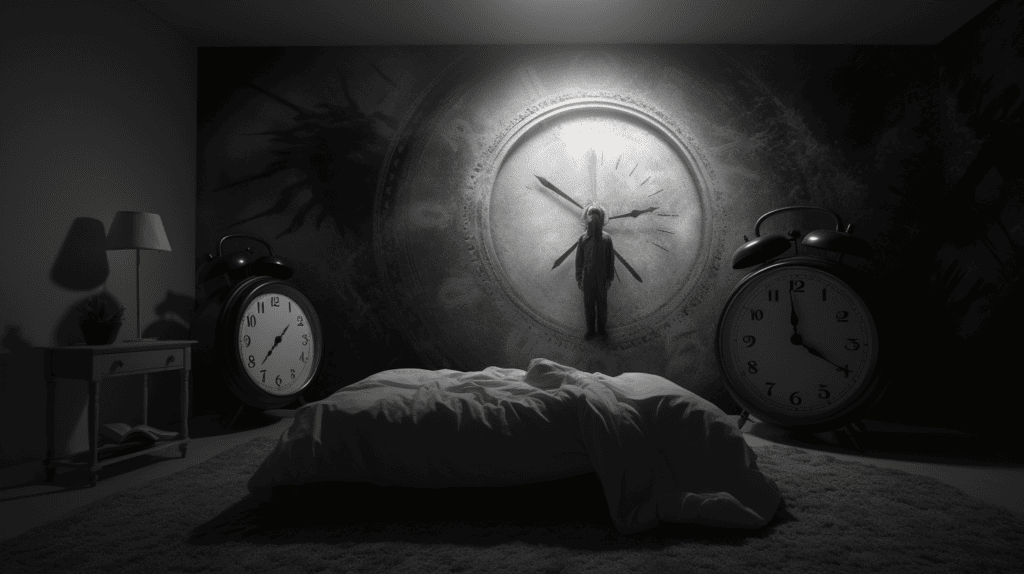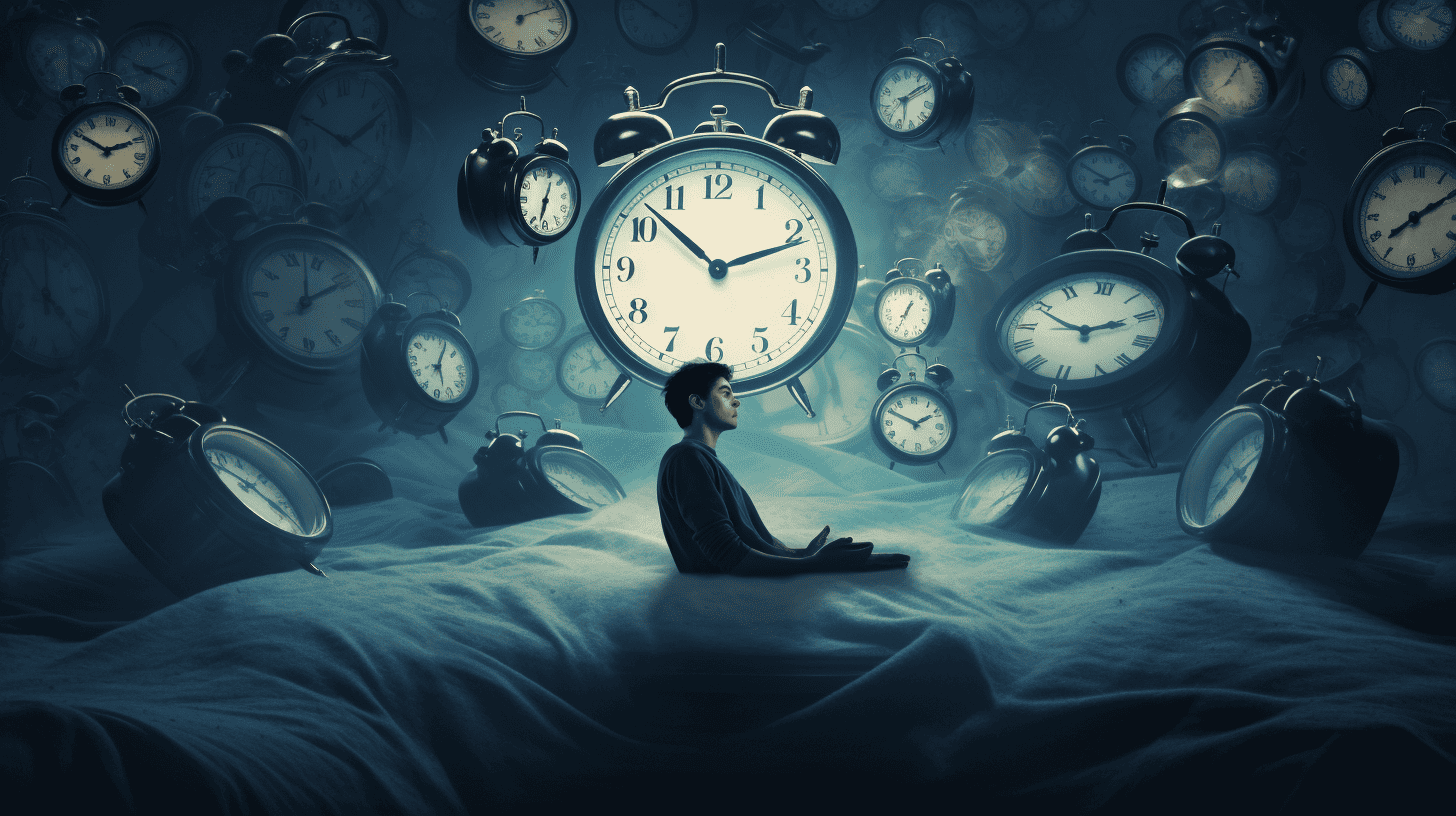Are you tired of not being able to control your dreams? Do you wish to explore the depths of your subconscious with ease? Look no further!
The Wake Back To Bed technique is here to help. This technique allows you to enter into a lucid dreaming state, where you can explore and even control your dreamscapes like never before.
Stop letting your dreams pass by in a blur – take control with this amazing technique!
Key Takeaways
- WBTB is a powerful lucid dreaming tool that involves waking up after 5-6 hours of sleep and staying awake for a period of time before returning to bed.
- Using WBTB increases the chances of experiencing conscious dreaming, deepens the connection with oneself in the dream state, and helps increase dream recall.
- Lucid dreaming is being conscious and aware while dreaming, and it can be used to explore the inner world, improve sleep quality, and gain insight.
- Practicing WBTB and lucid dreaming can improve problem-solving skills, reduce anxiety and depression symptoms, enhance sleep quality and dream recall, and allow for more accurate dream interpretation.
The WBTB Lucid dreaming technique

WBTB is a powerful lucid dreaming tool that has been used for many years to help people reach higher states of awareness while in the dream world.
It involves waking up after 5-6 hours of sleep and staying awake for a period of time before returning back to bed.
The importance and benefits of using this technique are tremendous, as it helps increase your chances of experiencing conscious dreaming, understanding your dreams better, and deepening your connection with yourself in the dream state.
Importance and benefits of using WBTB for lucid dreaming
Using the Wake Back To Bed (WBTB) method can help you experience lucid dreaming. This technique offers many benefits, including exploring your subconscious, gaining insight into creative solutions to problems, and managing stress or fear more effectively.
WBTB requires a shift in sleep routine and wake timing considerations. It involves setting an alarm to wake up after a few hours of sleep, staying awake for a short period of time, and then going back to sleep.
Incorporating reality checks into your daily life is also part of the technique’s principles. Reality checks involve questioning your surroundings and checking if you are dreaming or awake. This practice helps you develop a habit of questioning reality, which can carry over into your dreams.
With commitment, this technique can help you unlock its potential rewards. By consistently practicing WBTB and reality checks, you increase your chances of experiencing lucid dreaming and reaping its benefits.
Understanding the basics of lucid dreaming
Lucid dreaming is an experience in which you’re conscious and aware that you’re dreaming. It can be used as a tool to explore your inner world, gain insight, and develop creative problem-solving skills.
The potential applications of lucid dreaming range from increasing self-awareness to improving sleep quality and emotional regulation. With practice, anyone can learn how to lucid dream and reap the mental, emotional, and spiritual benefits that come with it.
Benefits and potential applications of lucid dreaming
The potential applications of lucid dreaming are vast. They range from improving creativity and problem-solving skills to reducing anxiety and depression symptoms.
One of the benefits of the lucid dreaming process is that dream recall increases. This allows for more accurate dream interpretation. Additionally, sleep quality can be improved while also increasing dream awareness.
Some specific benefits of lucid dreaming include:
- Enhancing problem-solving skills
- Reducing anxiety and depression symptoms
- Improving sleep quality and dream recall
How does the Wake Back to Bed technique work

The Wake Back to Bed (WBTB) technique is an effective way to increase the chances of having a lucid dream. It works by interrupting the normal sleep cycle and inducing wakefulness during REM sleep when most dreams occur.
This triggers the brain into a state in which it can become aware that it is dreaming, thus creating a lucid dream experience.
Explanation of the principles behind WBTB
WBTB, or Wake Back to Bed, relies on the idea of setting an alarm to wake you up after a few hours of sleep. Then, you stay awake for a certain period of time before going back to bed.
Using this method, you can create conditions that are favorable for lucid dreaming. These conditions include affirming intention, understanding sleep cycles, increasing dream recall, and doing reality checks.
This technique is beneficial in helping people get better quality sleep and achieve their desired goals.
How WBTB increases chances of having lucid dreams
Now that you understand the principles behind Wake Back to Bed (WBTB) technique, let’s explore how it can increase your chances of having lucid dreams.
Through wake scheduling, WBTB allows you to time your sleep cycle and take advantage of when REM sleep is most likely to occur.
In addition, combining WBTB with other lucid strategies like reality checks and dream intention can help you become more aware and conscious while dreaming.
With practice, WBTB can be an effective way to experience lucid dreaming.
Role of interrupting sleep cycles and inducing wakefulness
By interrupting your sleep cycles and inducing wakefulness, you can take advantage of REM sleep and increase your chances of having lucid dreams. This technique is known as the Wake Back To Bed (WBTB) Method.
- Wake up after 5-6 hours of sleep.
- Stay awake for 30 minutes to an hour doing dream recall exercises or reality checks.
- Return to bed and attempt to enter a lucid dream state.
This WBTB method helps you recognize signs of dreaming, boost dream recall, and become consciously aware during the dreaming process – all leading to successful lucid dreaming experiences!
Video on the wbtb method
Preparing for the Wake Back to Bed technique
Preparing for the Wake Back to Bed technique can be a crucial part of its success. First, consider the timing and scheduling considerations that are important to this technique.
Make sure you create a comfortable sleep environment free of distractions so that you can get the most out of your rest.
Finally, develop a consistent sleep routine in order to maximize your body’s natural cycles.
Doing these three things will help ensure you get the best results from your Wake Back to Bed practice.
Timing and scheduling considerations
You’ll want to decide when you’re going to practice the wake back to bed technique and make sure it fits into your schedule.
Develop a routine, set alarms, and prepare your mindset.
Don’t forget reality checks and be aware of potential sleep deprivation.
- Developing a routine
- Setting alarms
- Mindset preparation
Developing a consistent sleep routine
Establishing a consistent sleep routine is essential for successful lucid dreaming. To create habits, focus on sleep hygiene, track your sleep, and set habitual triggers.
Incorporate dream journaling to:
- Help understand dreams better
- Identify patterns in behavior
- Increase awareness of the subconscious mind
The actual steps of the Wake Back to Bed technique
If you’re looking to have an amazing lucid dreaming experience, the Wake Back To Bed technique is a great way to do it.
By setting an alarm and waking up after a certain duration of sleep, staying awake and engaging in lucid dreaming activities, then returning to bed and attempting to induce lucid dreaming, you’ll be on your way to having an incredible time!
Setting an alarm and waking up after a certain duration of sleep
Set your alarm for a certain amount of time that you decide is enough sleep, so you can wake up and get back to bed. Alarm scheduling, lucid intention, and reality checks are important for the success of this technique.
Wake motivation is also key. Sleep cycles should be taken into account when setting the alarm to ensure optimal results.
Be sure to stick with it and practice regularly!
Staying awake and engaging in lucid dreaming activities
Staying awake and engaging in lucid dreaming activities can be challenging, but with the right mindset and focus, it’s possible.
Lucid techniques such as dream imagery, dream recall, and dream control can help increase awareness of dreams.
Additionally, following good sleep hygiene practices like keeping electronics out of the bedroom or avoiding caffeine before bedtime can make it easier to remain aware while sleeping.
With a bit of practice, anyone can learn to engage in lucid dreaming activities!
Returning to bed and attempting to induce lucid dreaming
Once you’ve mastered the techniques for staying awake and engaging in lucid dreaming activities, it’s time to return to bed and attempt to induce lucid dreaming.
To achieve this, focus on:
- Dream Interpretation – analyze your dreams and gain mental clarity
- Sleep Hygiene – practice healthy sleep habits
- Dream Recall – remember dream details for Lucid Thinking.
With these steps, you can become a master of lucid dreaming!
Tips and tricks for success with the Wake Back to Bed technique
You can increase the chances of success with the Wake Back to Bed technique by optimizing the wake period for lucid dream induction.
During this time, it is recommended that you engage in activities that are known to induce lucid dreaming such as visualization exercises or keeping a dream journal.
It is also important to maintain focus and intention throughout the process, so make sure to set reminders and stay consistent.
With these tips and tricks, you’ll be well on your way to achieving lucidity while following the Wake Back to Bed technique.
Optimizing the wake period for lucid dream induction
By optimizing the wake period for lucid dream induction, you’ll be able to maximize your chances of having a successful experience.
Gain control over your dreams by learning lucid dreaming fundamentals, exploring altered states, and perfecting dream recall techniques.
Additionally, create sleep hygiene practices and use dream control methods for best results.
- Lucid dreaming fundamentals
- Altered states exploration
- Dream recall techniques
Recommended lucid dreaming activities to engage in during the wake period
Engaging in recommended lucid dreaming activities during the wake period can help increase your chances of successful lucid dream induction.
Dream journaling, dream incubation, sleep hygiene, lucid meditation, and dream recall are all great techniques to practice.
Keeping a regular sleep schedule is key for optimal sleep hygiene.
To improve dream recall, make sure to write down any dreams you remember as soon as you wake up.
Lastly, use guided meditation or visualization to become aware of your dreaming state while asleep.
Maintaining focus and intention throughout the process
Maintaining focus and intention throughout the process is essential for successful lucid dreaming induction.
Utilize meditation techniques, practice dream recall, and maintain good sleep hygiene to increase mental awareness and lucidity.
Incorporate:
- Meditation techniques
- Dream recall
- Sleep hygiene for better mental awareness & lucid awareness.
Common challenges and solutions

You may find the Wake Back to Bed technique difficult at first. One of the biggest challenges is falling back asleep after you wake up in the night.
Another hurdle is dealing with grogginess or fatigue during your wake period. Don’t worry, though – there are some troubleshooting tips to help you improve your technique and make it more effective.
Difficulties in falling back asleep
It can be difficult to fall back asleep after waking up. There are a few key steps you can take to make it easier:
- Establish good sleep hygiene habits. This includes maintaining a consistent sleep schedule, creating a comfortable sleep environment, and avoiding stimulating activities before bed.
- Utilize dream recall techniques and relaxation exercises. Deep breathing, progressive muscle relaxation, and visualization can help calm your mind and body, making it easier to fall back asleep.
- Try keeping a dream journal for better insight into your dreams. Writing down your dreams can help you process any lingering thoughts or emotions, allowing your mind to relax and drift back off to sleep.
Dealing with grogginess or fatigue during the wake period
| Feeling groggy or fatigued during the wake period can be common, but there are ways to combat it. | Dream Recall | Sleep Hygiene | Wakefulness Techniques | Lucid Dreaming Techniques | Reality Checks |
|---|---|---|---|---|---|
| Keep a sleep journal and practice dream recall. | Maintain regular sleep schedule. | Be aware of light and noise levels. Restrict naps if needed. | Practice relaxation techniques. Do low-intensity activities. | Set lucid dreaming goals. Check reality regularly. | Perform mental checks to stay focused on task. |
Advanced techniques and variations
You’ve already taken the first step in mastering lucid dreaming with the wake back to bed technique. Now let’s explore how you can take your practice even further!
Combining WBTB with other lucid dreaming methods can help enhance results, so it’s worth experimenting with different techniques.
You might also consider adjusting the timing and duration of your wake periods to find what works best for you.
Combining WBTB with other lucid dreaming methods for enhanced results
Combining WBTB with other lucid dreaming methods can help you get even better results. Utilize meditation techniques, dream journaling, and look for dream signs to increase your chances of becoming aware while dreaming.
Improve your dream control by keeping a sleep diary and gaining an understanding of sleep hygiene. With practice, you’ll be able to achieve greater control over your dreams and have more vivid experiences.
Experimenting with different wake times and durations
If you’ve experimented with combining the wake back to bed technique (WBTB) with other lucid dreaming methods, it’s time to take your practice to the next level.
Mental preparation, sleep scheduling, dream recall, and sleep hygiene are all important when experimenting with different wake times and durations.
To maximize your success, be sure to engage in some wakeful activities while remaining relaxed during the WBTB interval!
Exploring personalized approaches and modifications to suit individual preferences
Customizing the wake back to bed technique to suit your individual lucid dreaming goals can help you get the most out of your practice.
When exploring preferences, consider:
- Managing fatigue by keeping sleep sessions short and taking naps during the day.
- Personalizing approaches by adjusting wake times and durations that best work for you.
- Maintaining focus and increasing chances of success through regular meditation and visualization practices.
Safety precautions and concluding thoughts
You should always be mindful of potential sleep disruptions or disorders when attempting the Wake Back to Bed technique.
Listen to your body and adjust the technique accordingly if you don’t feel comfortable doing it.
Despite safety precautions, we encourage you to explore this technique and take steps toward mastering lucid dreaming.
Warnings about potential sleep disruptions or disorders
It’s important to be aware that the Wake Back to Bed technique may not work for everyone, and could disturb your sleep patterns or trigger a sleep disorder. Some potential issues include:
- Sleep deprivation effects from long wbtb attempts
- Lucid dreaming basics not understood completely
- Lucid dream benefits outweighed by difficulty of preparation and alarm setting
Listening to the body and adjusting the technique accordingly
Pay attention to your body’s signals and adjust the WBTB method accordingly. Listen for signs of fatigue, such as yawning or drooping eyelids, and be aware of your sleep-wake cycles.
Prepare mentally for lucidity and gain clarity on your intention before beginning. With this awareness, you can ensure that lucid dreaming happens at the right times and with maximum effectiveness.
References and additional resources

If you’re interested in learning more about the wake back to bed technique and its effectiveness, there are a variety of resources available.
Start by citing relevant studies and research on the subject from trusted sources such as scientific journals or articles.
Additionally, there are books, websites, podcasts, and other sources that offer further reading and guidance on this topic.
With a little bit of research, you can find trustworthy information to help you better understand the benefits of using this method.
Citing relevant studies and research on the effectiveness of the technique
You’ll find that there are many studies and research that have shown the effectiveness of the wake back to bed technique. These include:
- Meditative practices to help induce lucid dreaming
- Dream incubation techniques to increase dream recall
- Keeping a dream journal and practicing good sleep hygiene for better results.
With these tools, you can improve your quality of sleep and begin to use the wake back to bed technique with efficacy!
Understanding the Science behind the WBTB Technique
The WBTB technique exploits the natural sleep cycles and stages in order to increase dream recall and induce lucid dreams.
To understand the science behind this process, it is important to look at the different sleep stages and how they can be manipulated.
Explanation of sleep cycles and stages
Sleep cycles and stages refer to the different phases of sleep we experience each night. From dream recall to lucid dreaming, these cycles are key for gaining dream control and avoiding sleep deprivation.
1) Non-REM Sleep: deep relaxation and physical restoration.
2) REM Sleep: vivid dreams and memory consolidation.
3) Awake State: awareness and alertness.
Knowing this can help you make the most of your WBTB technique!
How WBTB exploits these sleep cycles to increase dream recall and induce lucid dreams
Exploiting the sleep cycles and stages of non-REM, REM, and wakefulness, WBTB can help you increase dream recall and induce lucid dreams.
It works by waking up after five hours of sleep to spend a period of time focusing on lucid dreaming motivations and reality checks before returning to bed.
This helps you become more aware during the REM stage of your sleep cycle, potentially leading to increased dream recall and experiences with lucidity.
WBTB offers many benefits for those wishing to explore the world of lucid dreaming!
Step-by-Step Guide on Practicing the WBTB Technique

You can harness the power of the WBTB technique to increase your chances of having a lucid dream.
To get started, you need to choose the right time to wake up in the middle of the night. Once awake, there are techniques you can use to help relax and adjust your mindset so that you remain alert but not overly stimulated.
During this period of wakefulness, it is important to maintain a level of relaxed alertness without becoming too active or overstimulated.
Maintaining the right level of wakefulness during the awake period
Striking the right balance of alertness and relaxation during your wakefulness period is key to achieving success with the WBTB method.
To stay alert, try setting an alarm at a specific time. Adjust your sleep environment to promote wakefulness. Set lucid intentions for dream recall to keep your mind focused on the goal.
Remember these key words: Staying Alert, Dream Recall, Alarm Settings, Sleep Environment, Lucid Intentions.
Returning to sleep with a clear intention of lucid dreaming
After waking for your WBTB session, it’s important to return to sleep with a clear goal of achieving lucid dreaming.
Utilize dream interpretation and recurring dreams to help increase your awareness of this state.
Practice mindfulness techniques such as dream recall and lucid awareness to aid in the process.
With consistent practice, you’ll soon be able to enter into lucid dreaming states with ease!
Tips and Strategies for Successful WBTB Practice
Getting the most out of your WBTB practice requires a few key steps. First, set an effective alarm for 4-6 hours after you fall asleep to wake up during a light sleep state. This will make it easier to transition back into sleep later.
Next, create a conducive sleeping environment by reducing noise and light as much as possible. This will help you relax and feel more comfortable when you go back to bed.
During the awake period, utilize reality checks to increase your chances of having a lucid dream. These can include simple actions like pinching yourself or looking at your surroundings to see if they match up with reality.
How to set an effective alarm
Choosing an effective alarm is key to the wake back to bed technique. Develop a sleep routine and pre-sleep habits that support your goal of lucid visualization and dream recall. Get creative with your alarm scheduling:
- Set multiple alarms at different intervals.
- Utilize a variety of sounds and tones.
- Make sure the alarm won’t disturb your partner’s sleep!
Utilizing reality checks during the awake period
Now that you’ve created an ideal sleeping environment for the Wake Back to Bed technique, it’s time to focus on reality checks during your awake period.
To help build lucid awareness and interpret reality correctly, start with mental preparation. Make a list of three things you should do:
1) Establish wake habits like drinking water or exercising.
2) Develop sleep rituals such as reading or meditating.
3) Practice quick mental checks multiple times a day.
Doing these will help you become more aware and better interpret reality.
Advanced WBTB Techniques for Experienced Lucid Dreamers
If you’re an experienced lucid dreaming practitioner, you may find it helpful to combine the Wake Back To Bed (WBTB) technique with other induction methods for enhanced dream recall and increased conscious awareness while in a dream.
By using WBTB, you can target specific dream content or experiences and practice the art of lucid dreaming even more deeply.
With some careful planning and experimentation, this powerful tool can help you take your lucid dreaming journey to new heights.
Combining WBTB with other induction methods
Combining WBTB with other induction methods can help you fall asleep faster. Try:
- Using lucid dreaming music
- Changing wake times
- Combining WBTB with diet, meditation, and setting intentions while asleep.
It’s an effective way to get better rest and achieve lucidity in your dreams.
Using WBTB to target specific dream content or experiences
By using WBTB to focus your intention, you can more easily target specific dream content or experiences.
Dream designing, sleep hygiene, mind programming, and mental clarity practices can help reduce stress while increasing your ability to manifest desired dream experiences.
Knowing what you want to experience in the dream world allows you to design a plan for achieving this goal through WBTB.
This technique helps eliminate unnecessary obstacles and distractions that may prevent you from achieving your goals in the dream state.
Final Thoughts
By consistently practicing the Wake Back to Bed technique, you can become an experienced lucid dreamer. The key is to stay persistent and consistent in your efforts.
As the old saying goes, ‘Practice makes perfect.’ With enough practice and patience, you’ll be able to reap the benefits of lucid dreaming with ease.
So why wait? Get started today and transform your dreams into a reality!
FAQ’s
Q: What is the wake back to bed technique?
A: The wake back to bed technique, also known as the WBTB method, is a lucid dreaming technique. It involves waking up from sleep and then going back to bed with the intention of becoming lucid in a dream.
Q: How does the WBTB method work?
A: The WBTB method works by taking advantage of the REM cycle, which is the stage of sleep where dreaming occurs. By waking up during the REM cycle and then going back to sleep, you increase your chances of having a lucid dream.
Q: What are some techniques for inducing lucid dreams?
A: Some techniques for inducing lucid dreams include the Mnemonic Induction of Lucid Dreams (MILD) technique, the Wake Back to Bed (WBTB) technique, and the Wake Initiated Lucid Dream (WILD) technique.
Q: How can I do the wake back to bed technique?
A: To do the wake back to bed technique, set an alarm to go off a few hours before you normally wake up. When the alarm goes off, get out of bed and stay awake for a short period of time. Then, go back to bed with the intention of having a lucid dream.
Q: How long should I stay awake during the wake back to bed technique?
A: The amount of time you stay awake during the wake back to bed technique can vary, but it is usually recommended to stay awake for around 20-30 minutes.
Q: What are the benefits of the wake back to bed technique?
A: The wake back to bed technique can increase your chances of becoming lucid in a dream. It allows you to enter a dream state directly after waking up, which can make it easier to recognize that you are dreaming and become lucid.
Q: How does the wake back to bed technique improve your chances of having a lucid dream?
A: The wake back to bed technique improves your chances of having a lucid dream by increasing your awareness and alertness during the transition from wakefulness to sleep. It helps you maintain consciousness as you enter a dream, making it easier to become lucid.
Q: Can anyone use the wake back to bed technique?
A: Yes, anyone can use the wake back to bed technique to try to have a lucid dream. However, it may be more effective for individuals who have some experience with lucid dreaming or who are already familiar with other lucid dreaming techniques.
Q: Is the wake back to bed technique a popular lucid dreaming method?
A: Yes, the wake back to bed technique is a popular lucid dreaming method. Many lucid dream enthusiasts have found success with this technique and use it regularly to induce lucid dreams.





Leave a Reply